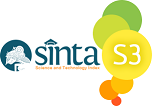Perbandingan Metode Propensity Score Matching- Support Vector Machine dan Propensity Score Matching-Regresi Logistik Biner Pada Kasus HIV/AIDS
DOI:
https://doi.org/10.31851/sainmatika.v17i3.4925Keywords:
ATT, Confounding, HIV/AIDS, PBR, PSM-Regresi Logistik Biner, PSM-SVM.Abstract
Penelitian non-experimental dapat dilakukan diberbagai bidang salah satunya bidang kesehatan. Dalam bidang kesehatan Randomized Controlled Trials (RCT) tidak dapat dilakukan karena berhubungan dengan nyawa manusia. Kovariat pada penelitian non-experimental biasanya tidak seimbang antara kelompok treatment dan kontrol. Ketidakseimbangan ini menyebabkan estimasi efek perlakuan menjadi bias. Selain itu, adanya variabel confounding juga mengakibatkan estimasi efek perlakuan bias. Metode yang sesuai untuk mengatasi efek perlakuan yang bias adalah metode Propensity Score (PS). Salah satu metode yang dikembangkan dari propensity score adalah metode Propensity Score Matching (PSM). Pada penelitian ini, peneliti akan membandingkan performa metode propensity score matching-support vector machine dan metode propensity score matching-regresi logistik biner pada kasus infeksi oportunistik HIV/AIDS. Variabel confounding yang digunakan dalam penelitian ini adalah variabel infeksi oportunistik. Data yang digunakan dalam penelitian ini adalah data pasien HIV/AIDS yang di rawat di Puskesmas Grati, Kabupaten Pasuruan pada tahun 2016. Hasil analisis propensity score matching-support vector machine dan metode propensity score matching-regresi logistik biner menunjukkan bahwa variabel pemberian terapi ARV berpengaruh secara signifikan terhadap infeksi oportunistik pada pasien HIV/AIDS. Jika dilihat seberapa bias yang dapat tereduksi, propensity score matching-regresi logistik biner mampu mereduksi bias lebih besar dibanding metode propensity score matching-regresi logistik biner yaitu sebesar 60,25%. Namun, metode propensity score matching-support vector machine dapat menghasilkan nilai bias (setelah matching) yang lebih kecil dibanding metode propensity score matching-regresi logistik biner yaitu sebesar 0,044.
References
Becker, S. O., & Ichino, A. (2002). Estimation of Average Treatment Effect Based on Propensity score. The Stata Journal, 2, 358–377.
Center for Disease Control and Prevention (CDC). 2018. About HIV/AIDS.
Fenner, L., Reid, S. E., Fox, M. P., Garone, D., Wellington, M., Prozesky, H., & Boulle, A. (2013). Tuberculosis and the risk of opportunistic infections and cancers in HIVâ€infected patients starting ART in Southern Africa. Tropical Medicine & International Health, 18, 194-198.
Guo, S., & Fraser, M. W. (2010). Propensity score analysis: Statistical methods and applications. Thousand Oaks, CA: Sage Publications.
Haerdle, W. W., Prastyo, D. D., & Hafner, C. (2014). Support Vector Machines with Evolutionary Model Selection for Default Prediction. In Racine, J., Su, L., & Ullah, A., The Oxford Handbook of Applied Nonparametric and Semiparametric Econometrics and Statistics (pp. 346-373). Oxford University Press.
Hosmer, D., & Lemeshow, S. (2000). Applied Logistic Regression (2 ed.). New York: John Wiley & Sons.
Last, J. M., Silva, I. D. S., Hernan, M. & Greenland, S. (1983). A Dictionary of Epidemiology 6 th edition. A Handbook Sponsored By The IEA.
Li, M. (2013). Using the propensity score method to estimate causal effects: A review and practical guide. Organizational Research Methods, 16, 188-226.
Nugroho, A. S., Witarto, A. B., & Handoko, D. (2003). Support Vektor Machine: Teori dan Aplikasinya dalam Bioinformatika. Kuliah Umum Ilmu komputer.com, Indonesia.
Rosenbaum, P. R., & Rubin, D. B. (1985). Constructing a Control Group Using Multivariate Matched Sampling Methods that Incorporate the Propensity Score. American Statistician, 39, 33–38.
Rosenbaum, P. R., & Rubin, D. B. (1983). The Central Role of the Propensity Score in Observational Studies for Causal Effects. Journal Biometrika, 70, 41-55.
Otok, B. W., Aisyah, A., Purhadi, & Andari, S. (2017). Propensity score matching of the gymnastics for diabetes mellitus using logistic /regression. AIP Conference Proceedings 1913, 020034.
Pan, W., & Bai, H. (2015). Propensity Score Analysis: Fundamentals and Developments. New York: Guilford Press.
Pal, M., & Mather, P. M. (2005). Support Vector Machines for Classification in Remote Sensing. International Journal of Remote Sensing, 26, 1007–1011.
Yao, B., Zhang, L., Liang, S., & Zhang, C. (2012). SVMTriP: A Method to Predict Antigenic Epitopes Using Support Vector Machine to Integrate Tri-Peptide Similarity and Propensity. Plos One, 7, e45152.
Yanovitzky, I., Zanutto, E., & Hornik, R. (2005). Estimating Causal Effects of Public Health Education Campaigns Using Propensity Score Methodology. Evaluation and Program Planning, 28, 209-220.Young, M. J., Boulton, A. J. M., Macleod, A. F., Williams, D. R. R. & Sonksen, P. H. S. (1993). A Multicentre Study of The Prevalence of Diabetic Peripheral Neuropathy in The United Kingdom Hospital Clinic Population. Diabetologia, 36, 150-154.
B-Lajoie, M. R., Drouin, O., Bartlett, G., Nguyen, Q., Low, A., Gavriilidis, G., ... & Muhe, L. (2016). Incidence and prevalence of opportunistic and other infections and the impact of antiretroviral therapy among HIV-infected children in low-and middle-income countries: a systematic review and meta-analysis. Clinical infectious diseases, 62(12), 1586-1594.








